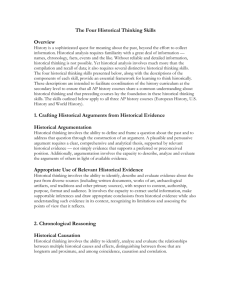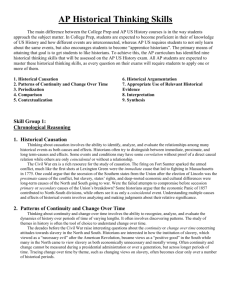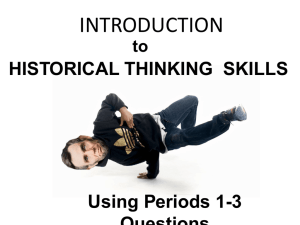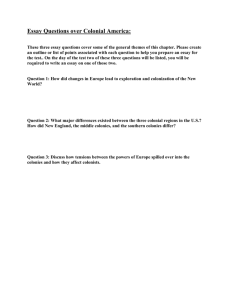Writing in AP U.S. History
advertisement
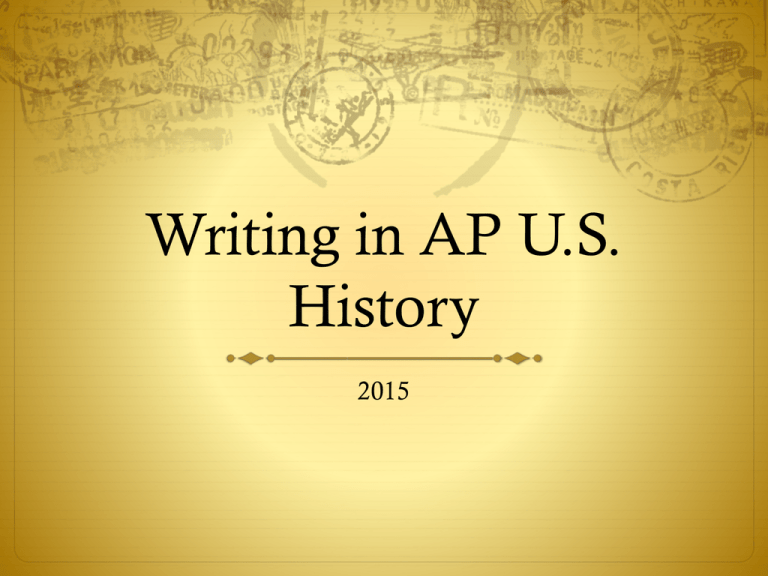
Writing in AP U.S. History 2015 Objectives TSW analyze the historical thinking skills. TSW discuss the important of these historical thinking skills. AP U.S. History Exam Section Question Type Number of Questions Timing Percentage of Total Exam Score I Part A; MultipleChoice 55 questions 55 minutes 40% Part B: ShortAnswer 4 questions 45 minutes 20% Part A: DBQ 1 question 60 Minutes 25% Part B: Long Essay 1 question (chosen from a pair) 35 Minutes 15% BREAK II Historical Thinking Skills Historical Argumentation Use of Relevant Historical Evidence Historical Causation Patters of Continuity and Change Over Time Periodization Compare and Contrast Contextualization Interpretation Synthesis HTS Historical Argumentation: Historical thinking involves the ability to define and frame a question about the past and to address that question by constructing an argument. A plausible and persuasive argument requires a clear, comprehensive and analytical thesis, supported by relevant historical evidence—not simply evidence that supports a preferred or preconceived position. Additionally, argumentation involves the capacity to describe, analyze and evaluate the arguments of others in light of available evidence HTS Use of Relevant Historical Evidence: Historical thinking involves the ability to identify, describe and evaluate evidence about the past from diverse sources (including written documents, works of art, archaeological artifacts, oral traditions and other primary sources), with respect to content, authorship, purpose, format and audience. It involves the capacity to extract useful information, make supportable inferences and draw appropriate conclusions from historical evidence while also understanding such evidence in its context, recognizing its limitations and assessing the points of view that it reflects. HTS Historical Causation: Historical thinking involves the ability to identify, analyze, and evaluate multiple causeand-effect relationships in a historical context, distinguishing between the long-term and proximate. Patterns of Continuity and Change Over Time: Historical thinking involves the ability to recognize, analyze and evaluate the dynamics of historical continuity and change over periods of time of varying lengths, as well as relating these patterns to larger historical processes or themes. Historical Causation WHY did stuff happen? What was the impact? Think long and short-term. Continuity and Change Over Time What stayed the same? What changed? Why did it change and how much did it change? HTS Periodization: Historical thinking involves the ability to describe, analyze, evaluate and construct models of historical periodization that historians use to categorize events into discrete blocks and to identify turning points, recognizing that the choice of specific dates favors one narrative, region or group over another narrative, region or group; therefore, changing the periodization can change a historical narrative. Moreover, the particular circumstances and contexts in which individual historians work and write shape their interpretations and modeling of past events. Periodization Why do historians start and end time periods when they do? Turning points! HTS Compare and Contrast: Historical thinking involves the ability to describe, compare and evaluate multiple historical developments within one society, one or more developments across or between different societies, and in various chronological and geographical contexts. It also involves the ability to identify, compare and evaluate multiple perspectives on a given historical experience. Comparison Identify similarities and differences within a society or between societies—could be chronological, ideological, demographic, geographic, political, economic, social HTS Contextualization: Historical thinking involves the ability to connect historical developments to specific circumstances in time and place, and to broader regional, national or global processes. Interpretation: Historical thinking involves the ability to describe, analyze, evaluate and create diverse interpretations of the past—as revealed through primary and secondary historical sources—though analysis of evidence, reasoning, contexts, points of view and frames of reference. Contextualization Connecting events to their specific place and time in history HTS Synthesis: Historical thinking involves the ability to arrive at meaningful and persuasive understanding of the past by applying all the other historical thinking skills, by drawing appropriately on ideas from different fields of inquiry or disciplines and by creatively fusing disparate, relevant (and perhaps contradictory) evidence from primary sources and secondary works. Additionally, synthesis may involve applying insights about the past to other historical contexts or circumstances, including the present. Quiz 1. ________________ Tests often ask students to explain why one event or trait happened after or resulted from another. Which THREE prompts below would best be answered with an essay that emphasizes causation? a. Explain why American Indians were so diverse in 1491. b. How did Spanish colonies differ from English colonies? c. How did religious beliefs influence American colonization? d. Did Columbus reflect the values of the late 15th century Europe? e. Analyze the impact of colonization on Spain. 2. Statements that express causation often use words such as cause, effect, because, hence, and result. Which TWO of these statements best express causation? a. Because of Jackson’s Specie Circular, banknotes lost their value. b. Jackson’s threat to use force and his willingness to compromise on the tariff persuaded the states’ rights advocates to back down. c. Jackson charged that Adams and Clay made a “corrupt bargain.” d. The Anti-Masonic party viewed the Masons as a group of secret elite. 3. Essay questions often ask students to focus on how a society has stayed the same or evolved over time. Which THREE of the questions or statements below would best be answered with an essay that emphasizes historical continuity and change over time? a. How did Massachusetts and the Chesapeake colonies differ? b. Use examples from both New England and Virginia to show the development in colonial America of a pattern of resistance to authority. c. Describe how attitudes toward equality evolved during the colonial era. d. Between 1607 and 1754, did the colonies become more or less like England? e. What caused the colonial economy to prosper? 4. Statements about continuity often include phrases such as “similar to” or “following in the path.” Statements about change often include phrases such as “unlike” and “unprecedented.” Which THREE of the following statements best express either continuity or change? a. The Second Great Awakening was one of the many reform movements that swept the country in the 1800s. b. Some historians believe that the strong sense of taking care of one another that existed in frontier settlements in the 1800s can be traced directly to the values of the Puritans of the 1600s. c. African American leaders in the first half of the 1800s responded to slavery in various ways. d. Henry David Thoreau’s legacy was revived by reformers in both the United States and India in the 20th century. e. Listing the subjects portrayed in American painting in the 1780s and in the 1850s demonstrates how significantly the United States evolved in just seven decades. 5. Historians divide the flow of past events into periods that share common traits. They identify key dates that mark turning points. The choice of those traits and turning points reflects a historian’s point of view. Which THREE of the following essay questions ask for an answer that emphasizes periodization? a. Compare and contrast the ideas and influences of Jonathan Edwards and George Whitefield. b. How did the 1730s mark an important shift in colonial religious history? c. The years from 1607 to 1733 can be called the Era of English Settlement. Explain whether you think this label fits the era. d. Describe the trend in ethnic diversity in the English colonies between 1607 and 1775. e. The Massachusetts school of law of 1647 marked the beginning of a new era in American education. 6. Which TWO of the following statements best demonstrate the significance of periodization? a. The Clayton-Bulwer Treaty of 1850 was a defensive measure against the expansion of British influence in Central America. b. The great era of American expansion began not in 1830, but in 1803 with Jefferson’s decision to purchase the Louisiana Territory. c. In the history of American expansion, 1860 is a meaningless date: the national attitude toward expansion was the same before and after that year. d. The vote on the Wilmot Proviso demonstrated how members of Congress felt about the expansion of slavery. e. The Ostend Manifesto was just a footnote in the long story of efforts by the United States to obtain Cuba. 7. Historians often compare events to highlight similarities and differences. They might compare two contemporary developments or two developments in different time periods. Which THREE of the questions or statements below would be best answered with an essay that emphasizes comparison? a. How did Pontiac’s Rebellion support the British argument for the Proclamation of 1763? b. Explain how the Declaratory Act was a cause of the Boston Tea Party. c. Describe the similarities between Patrick Henry and James Otis. d. How was the relationship between the colonies and Great Britain before and after the Seven Years’ War different? e. Analyze differences between Bacon’s Rebellion and the Stamp Act Congress. 8. Which THREE of the following statements most clearly express comparisons or contrasts? a. The reactions to both the Wilmot Proviso and the Ostend Manifesto demonstrated how sensitive the issue of slavery expansion was. b. Douglas combined a desire to advance his personal interest in railroad expansion with a desire to keep the Union together. c. Henry Clay was a great legislative leader because he believed in compromise. d. While Harriet Beecher Stowe’s book was fictional and literary, Hinton Rowan Helper’s book was nonfiction and statistical. e. John Brown shared similarities with Anne Hutchinson, Patrick Henry, and Nat Turner. 9. Contextualization is explaining and evaluating how an event is shaped by broader trends or its historical setting. Which THREE of the items below would be best answered with an essay that emphasizes contextualization? a. Explain how geography shaped the conflict between Great Britain and its American colonies. b. How did the Enlightenment influence the American Revolution? c. Explain why the ideas expressed in the Articles of Confederation would make conducting a war difficult. e. What caused the American Revolution? d. How did the American and French revolutions differ? 10. Which THREE of the following statements best express the idea of contextualization? a. While slavery ended throughout the Americans in the late 1700s and during the 1800s, the United States and Haiti were the only two places where it ended through large-scale violence. b. The Republican economic plans carried out the ideas expressed in earlier days by Alexander Hamilton and Henry Clay. c. The Emancipation Proclamation was written in rather boring language. d. Considering that Sherman’s March was conducted as an act of war, remarkably few people died from it. e. General Robert E. Lee’s decision to join the Confederacy provides a fascinating look into how he thought about the world. 11. Which TWO of the following statements best demonstrate the skill of placing an event in context? a. Wages for American workers, though low, were higher than wages for similar workers in Europe. b. The creation of time zones demonstrated the nationalization of events and behavior in the late 19th century. c. Eugene Debs dedicated his adult life fighting for working people. d. Thomas Edison deserves great credit for his contributions to modern life. 12. A historical argument is a carefully written chain of thoughts that includes a clear thesis and analysis supported with evidence. Which THREE of the following questions would be best answered with an essay that makes a historical argument? a. Summarize the differences between the Federalists and the Anti-Federalists. b. Using more than one type of evidence, support or oppose this statement: “The Founders failed to see fundamental developments in American politics.” c. Explain whether you agree or disagree that differences in foreign policy in the 1700s were rooted in economic interests. d. Explain whether you think the information in this chapter supports or opposes the ideas that compromise has been an essential part of American government since the founding of the country, e. Explain the main points of Hamilton’s financial plan. 13. Which TWO of the following statements best express historical argumentation? a. Dunning’s view of Reconstruction was grounded in racial beliefs that almost no one accepts today. b. I agree with the efforts of Charles Sumner on Reconstruction. c. The Freedmen’s Bureau and Black Codes provide contradictory evidence for the conclusion that Reconstruction was a success. 14. Which TWO of the following statements most clearly include evidence to support the claim it makes? a. The Chinese Exclusion Act indicates the prejudice felt by many people in the United States in the late 19th century. b. George Washington Carver and Ida B. Wells demonstrated different methods of combating racial prejudice. c. Granges and cooperatives demonstrated the strong sense of community many Americans felt in the 19th century. 15. Which TWO of these questions asks for an essay that emphasizes the forces shaping how historians interpret the past? a. Explain why two historians might disagree about the federal government’s role in economic changes between 1816 and 1824. b. Describe two ways historians have viewed the Monroe Doctrine’s purpose. c. Analyze why the Era of Good Feelings ended so quickly. 16. Which TWO of the following statements best express historical interpretations? a. By giving people shared experiences as fans, spectator sports promoted the blending of diverse immigrants into Americans. b. Globalization in recent years has caused historians to focus on European influences on American culture in the late 19th century. c. People today still read the works of Jack London and Stephen Crane. 17. Synthesis requires combining information from multiple sources to answer a question or draw a conclusion. Which TWO of the following questions most clearly asks for an answer that uses synthesis? a. Use information from two different types of sources (print, statistical, visual, etc.) to explain why the West was more closely tied to the North than to the South by the 1850s. b. Who, if anyone, are the modern equivalents of mountain men? c. In the mid-1800s, Great Britain had several large cities and no slavery. Explain why the South was the U.S. region least like Britain but more closely tied to it. d. Why did Southerners refer to slavery as “that peculiar institution”?

